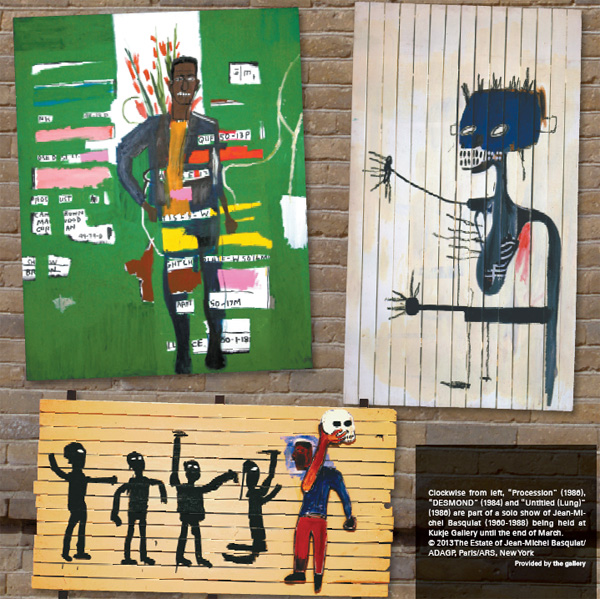Basquiat’s legend continues with solo Seoul show

Clockwise from left, “Procession” (1986), “DESMOND” (1984) and “Untitled (Lung)” (1986) are part of a solo show of Jean-Michel Basquiat (1960-1988) being held at Kukje Gallery until the end of March.ⓒ 2013 The Estate of Jean-Michel Basquiat/ADAGP, Paris/ARS, New York Provided by the gallery
Still, many in Korea haven’t had a chance to see Basquiat’s works in person or to consider whether his fame is purely from his paintings or is partly from the halo effect of his short and dramatic life. A solo show of the artist going on at Kukje Gallery presents that opportunity.
The exhibition features 18 works the American painter made between 1981 and 1988.
The gallery explained in a release that his paintings are characterized by eclectic references to historical black heroes (like jazz musician Charlie Parker, and baseball player Hank Aaron), comic books, anatomy, graffiti and issues of race.
Works on display such as “DESMOND” are clear examples of how Basquiat, as an African American, was interested in minority and social class issues.
But why anatomy? Basquiat was hit by a car at the age of 7 and while recovering from an operation in which his spleen was removed, his mother gave him a copy of the medical text Gray’s Anatomy. “Untitled (Hand Anatomy)” and “Untitled (Lung)” reveal his anatomical inspiration.
Death was also among Basquiat’s obsessions. “Untitled (Lung)” and “Procession” allude that death is unavoidable to all humans, just like old European paintings of the vanitas genre.
After participating in The Times Square Show in 1980, his first gallery hanging, he barreled down the expressway of fame, becoming the youngest artist to be invited to dOCUMENTA in Kassel, Germany, in 1982. But he became obsessed with the idea that galleries were abusing him. In 1988, Basquiat died of a drug overdose.
Asked whether his fame has grown swollen because of his dramatic life, art critic Yoo Jin-sang said, “Anyway, we can’t talk about American art of the 1980s without Basquiat, who represented the emergence of the counterculture and the sociopolitics of the time.”
The show runs through March 31. Admission is free. Hours are 10 a.m. to 6 p.m. Monday to Saturday, and until 5 p.m. Sundays. Go to Anguk Station, line No. 3, exit 1, and walk 10 minutes.
For more information, visit www.kukje.org or call (02) 735-8449.
By Moon So-young [symoon@joongang.co.kr]










with the Korea JoongAng Daily
To write comments, please log in to one of the accounts.
Standards Board Policy (0/250자)